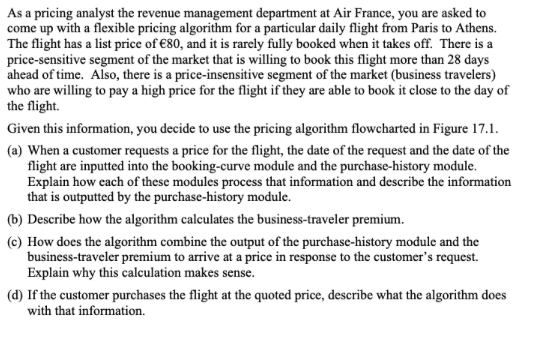

As a pricing analyst the revenue management department at Air France, you are asked to come up with a flexible pricing algorithm for a particular daily flight from Paris to Athens. The flight has a list price of 80, and it is rarely fully booked when it takes off. There is a price-sensitive segment of the market that is willing to book this flight more than 28 days ahead of time. Also, there is a price-insensitive segment of the market (business travelers) who are willing to pay a high price for the flight if they are able to book it close to the day of the flight. Given this information, you decide to use the pricing algorithm flowcharted in Figure 17.1. (a) When a customer requests a price for the flight, the date of the request and the date of the flight are inputted into the booking-curve module and the purchase-history module. Explain how each of these modules process that information and describe the information that is outputted by the purchase-history module. (b) Describe how the algorithm calculates the business-traveler premium. (C) How does the algorithm combine the output of the purchase-history module and the business-traveler premium to arrive at a price in response to the customer's request. Explain why this calculation makes sense. (d) If the customer purchases the flight at the quoted price, describe what the algorithm does with that information Customer price inquiry Date of inquiry and date of stay Booking curve module 1! Purchase-history module Business traveler premium = last-minute value-last-minute value x proportion of the 28 days remaining) p/sold), average selling price , Price = [p(sold) x average selling price) + business traveler premium Customer response Figure 17.1 As a pricing analyst the revenue management department at Air France, you are asked to come up with a flexible pricing algorithm for a particular daily flight from Paris to Athens. The flight has a list price of 80, and it is rarely fully booked when it takes off. There is a price-sensitive segment of the market that is willing to book this flight more than 28 days ahead of time. Also, there is a price-insensitive segment of the market (business travelers) who are willing to pay a high price for the flight if they are able to book it close to the day of the flight. Given this information, you decide to use the pricing algorithm flowcharted in Figure 17.1. (a) When a customer requests a price for the flight, the date of the request and the date of the flight are inputted into the booking-curve module and the purchase-history module. Explain how each of these modules process that information and describe the information that is outputted by the purchase-history module. (b) Describe how the algorithm calculates the business-traveler premium. (C) How does the algorithm combine the output of the purchase-history module and the business-traveler premium to arrive at a price in response to the customer's request. Explain why this calculation makes sense. (d) If the customer purchases the flight at the quoted price, describe what the algorithm does with that information Customer price inquiry Date of inquiry and date of stay Booking curve module 1! Purchase-history module Business traveler premium = last-minute value-last-minute value x proportion of the 28 days remaining) p/sold), average selling price , Price = [p(sold) x average selling price) + business traveler premium Customer response Figure 17.1








